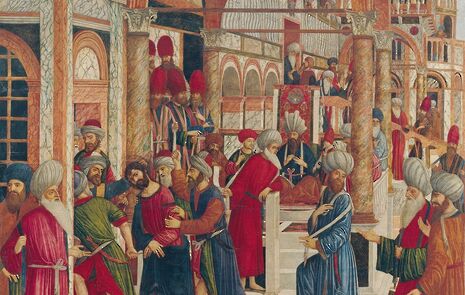Velvet back above the ground
Miriam Balanescu thinks about the historical roots of one of this season’s trendiests fabrics

Of all things, velvet is one of the most luxurious. Along with candles and incense, it shouts sensuality. Perhaps this is why it is one of the most popular fabrics, returning again and again to the catwalk. It has evolved, become much more accessible, and yet many know little about the material which has come back to collections this fall.
Velvet is made of looped silk; it is woven, and cut to create a pile effect. When it was first produced, this complex process was time-eating and expensive, making it a fabric bought only by those with money. Its origins are unclear; possibly it was first worn in Baghdad, and from then on we know it was sported in Cairo, Mali and Venice, mostly by the nobility.

This material’s popularity exploded during the Renaissance. You may have seen Hans Holbein’s portrait of Henry VIII in Trinity, in which he flaunts a red velvet robe with gold ornamentation. The Tudors were very fashion-conscious. Yet velvet was only worn by members of the Royal Court and the clergy, and the fabric was exported from Italy. Though it is now more available and a lot cheaper, there is still the notion that velvet is only for few individuals, belonging to dandyism or glamorous occasions, and that it should be kept to a minimum.
Vanessa Seward ignores this sentiment in her latest collection. She gives a more gender neutral spin on a former trend, dressing her female models in velvet suits, waistcoats and bow-ties. Because velvet is such a sumptuous material, it brings elegance to this formal wear. Ellery, in contrast, adds a mere touch of brilliant regal sapphire to outfits with high-heeled boots. Alessandro Michele seems highly aware of velvet’s Renaissance history in his latest collection. He slams together the style of the old English monarchy and 70s-80s trends, pairing sequins, florals and Oriental inspired patterns with velvet. Though the designs are certainly eclectic, the different eras are maybe uncomfortably forced together.
From chic evening-wear of the 1920s to the iconic little dress of 90s grunge, velvet does steal looks, draw glances, and works best as the statement piece of an outfit. It is tricky to incorporate it into casual clothing, and often, it seems, less of it is more. But there’s no doubt that this trend will continue to survive.
 News / Clare Hall spent over £500k opposing busway 24 December 2025
News / Clare Hall spent over £500k opposing busway 24 December 2025 News / Caius mourns its tree-mendous loss23 December 2025
News / Caius mourns its tree-mendous loss23 December 2025 Comment / The ‘class’ of Cambridge24 December 2025
Comment / The ‘class’ of Cambridge24 December 2025 Comment / Yes, I’m brown – but I have more important things to say22 December 2025
Comment / Yes, I’m brown – but I have more important things to say22 December 2025 Interviews / Politics, your own way: Tilly Middlehurst on speaking out21 December 2025
Interviews / Politics, your own way: Tilly Middlehurst on speaking out21 December 2025









